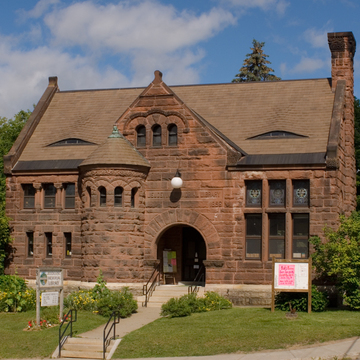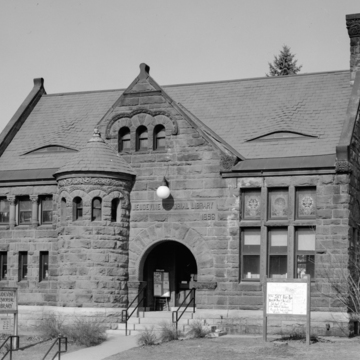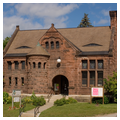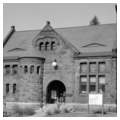The highest-style building in Hardwick village, the Jeudevine Library is a reflection of statewide and local circumstances. Although not incorporated until 1890, Hardwick was already experiencing an economic boom from its granite industry. In 1894, when the Vermont legislature mandated state assistance for the purchase of books by communities that established town-supported free public libraries, Hardwick was among the fifty-eight towns to take immediate advantage of the legislature's act. Following a pattern of private—and often female—support for local libraries, Malvina Tuttle Jeudevine, widow of businessman, landowner, and legislator Alden Jeudevine, commissioned Packard to design the building as a memorial to her husband and her son.
The result is a Romanesque Revival landmark of rock-faced red Libby, Massachusetts, sandstone on a Hardwick granite base that proclaims Packard's obvious debt to H. H. Richardson. With its wide-arched entrance framed by a cross-gable and engaged stair turret, eyebrow dormers, mullioned and transomed reading room windows, and book-stack gallery lighted by a band of windows punctuated by squat Romanesque columns, it is a smaller version of Richardson's Crane Memorial Library (1880–1882) in Quincy, Massachusetts. Although its lively alternating narrow and broad courses of masonry are carefully coordinated with sill and lintel heights to unify the building, it eschews the strong color contrasts found at Quincy and is more like Richardson's later, quietly monochromatic Billings Library in Burlington (CH19.2). Among other slight variations from the Crane library are the arcaded windows of the turret, framed by continuous foliated moldings. This fine, rich carving recurs in the ornamental band beneath the fascia of the turret, the bookstack gallery's capitals, and the elaborate flared cap on the reading room chimney. Within this shell, interiors of golden oak and stained glass make this a truly memorable small-town library.


















